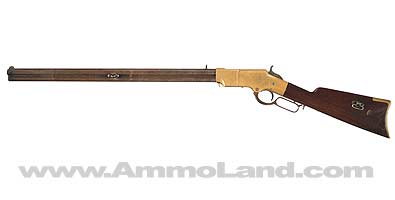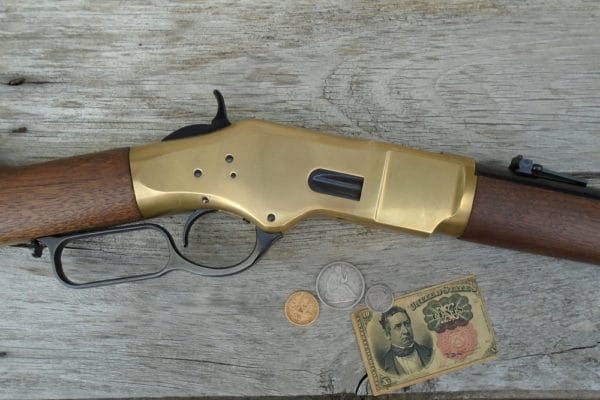U.S.A. –-(AmmoLand.com)- The lever-action repeating rifle that Benjamin Tyler Henry invented was a huge step forward in arms development, but there was still room for improvement, namely in terms of the loading mechanism.
Henry’s gun loaded from the muzzle and had an exposed magazine spring and follower. Loading from the muzzle presented challenges when in the prone position or on horseback, and the exposed spring and follower meant that the gun’s internals were open to dirt, sand, and other debris, as well as susceptible to getting bent or broken.

Your hand could also get in the way of the follower as it moved down the magazine tube, thereby preventing the gun from loading the next round. As the gun was fired and the barrel heated up, it was also easy for your hand to slip onto the barrel and get burned.
Oliver Winchester knew that improvements to Henry’s basic design had to be made if he was going to be able to properly market and sell a new version of the gun. A number of different ideas and methods were experimented with, but it was eventually narrowed down to two men and their respective patents.
These men were Nelson King and George Briggs.
King’s design included a loading gate on the right side of the receiver and a wooden forearm covering part of the magazine tube. The loading gate facilitated faster and easier reloads in a variety of positions and conditions, while the forearm protected the shooter’s hand from the heat of the barrel.
These improvements addressed the two biggest flaws with the Henry rifle.

Briggs’ design used a sliding magazine tube that you accessed from the rear of the tube nearest to the front of the frame, and did away with the exposed spring and follower. A button was pressed to release it from the frame and you would then slide the tube forward and insert the rounds before sliding the tube back into place.
While this solved the reloading flaw in the Henry, it didn’t address the barrel heat issue.

Ultimately, Winchester chose to go with King’s patent. The result was what we know today as the Model 1866. With the benefit of hindsight, we might think that choosing King’s improvements was a no-brainer, but that wasn’t the case back in 1866. Briggs’ design was a serious contender.

Oliver Winchester recognized the efforts that George Briggs had put forth, and he wanted to thank the inventor in a special way. He took one of the experimental prototype rifles, had it beautifully engraved, and then presented it back to Briggs. Of the handful of Briggs prototypes known to exist today, only one has any form of embellishment.
That gun was passed down through the Briggs family before being sold to a private collector in the mid-20th century. Today, it’s looking for a new home, and will find one during the May 2021 Arms and Armor sale held by Lewis & Grant Auctions. It has a presale estimate of $250,000-$350,000.

For a 150-plus-year-old gun, it’s in fantastic condition.
The barrel retains 100% of the original bright nickel finish. The brass frame has a lovely, untouched, butterscotch patina, in pristine unmarked condition. The hammer still retains most of its original bright case colors. The stock is a great piece of deluxe highly figured piano varnished walnut.
This Briggs gun is a sort of “missing link,” helping to bridge the gap between Henry and Winchester. Even though the design wasn’t adopted, it’s still an exceptionally important part of American arms development and a crucial part of the Winchester lever-action story.
About Logan Metesh
Logan Metesh is a historian with a focus on firearms history and development. He runs High Caliber History LLC and has more than a decade of experience working for the Smithsonian Institution, the National Park Service, and the NRA Museums. His ability to present history and research in an engaging manner has made him a sought after consultant, writer, and museum professional. The ease with which he can recall obscure historical facts and figures makes him very good at Jeopardy!, but exceptionally bad at geometry.


The Henry was a fascinating weapon but i can definitely imagine the hot metal from firing a handful of rounds.if i had to use one id make a brass wire foreend that allowed full travel of the follower button and kept my hand off the barrel. Of course the 66 was the best solution
I purchased the New 44-40 Henry with the engraved receiver last year. It is we very well balanced rifle which I have yet to fire. I also bought the Uberti 44-40 to shoot which is also well balanced.
The only cartridges I was able to obtain were 850 fps so I did not get to fire the Uberti with regular ammo.
Holding on to the Henry as a collectable.
\